Lecture 3 - Acculturation and Mental Health (Book chapters 7 and 14)
0.0(0)
0.0(0)
Card Sorting
1/106
Earn XP
Description and Tags
Study Analytics
Name | Mastery | Learn | Test | Matching | Spaced |
|---|
No study sessions yet.
107 Terms
1
New cards
Enculturation vs. acculturation
Enculturation: process of first-culture learning
Acculturation: process of cultural change when you interact with people from another culture (second-culture learning). Learning and adapting to a culture that is different from your own
E.g., native Americans dressing as Westerners = acculturation
Acculturation: process of cultural change when you interact with people from another culture (second-culture learning). Learning and adapting to a culture that is different from your own
E.g., native Americans dressing as Westerners = acculturation
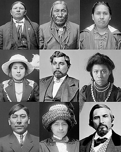
2
New cards
Heritage culture vs. Host culture
Heritage = original culture
Host = new culture
Host = new culture
3
New cards
Culture shock (crisis stage)
Feeling of being anxious, helpless, irritable, and generally disoriented and homesick on moving to a new culture
E.g., realizing that language skills are inadequate or unaware of how government system works
E.g., realizing that language skills are inadequate or unaware of how government system works
4
New cards
Cultural distance
Difference between two cultures in their overall ways of life
(the more cultural distance --> harder the acculturation process)
(the more cultural distance --> harder the acculturation process)
5
New cards
Reasons to study acculturation
We live in times of migration, contact, and diversity ("era of super-diversity")
Highly politicized topic
Highly politicized topic
6
New cards
What is migration?
The movement of a person or a group of persons, either across an international border, or within a state
"a population movement, encompassing any kind of movement of people, whatever its length, composition, and causes" (International Organization for Migration)
"a population movement, encompassing any kind of movement of people, whatever its length, composition, and causes" (International Organization for Migration)
7
New cards
Who migrates?
Economic migrants;
Sojourners;
Refugees;
Asylum seekers;
Displaced people
Sojourners;
Refugees;
Asylum seekers;
Displaced people
8
New cards
Push factors of migration
Conditions that drive people to leave their country (i.e., economic, social, or political problems)
Lack of opportunities;
Poverty;
Shortage of food;
Armed conflict;
Genocide;
Discrimination and/or persecution;
Natural disasters;
Bad education;
Unemployment
Lack of opportunities;
Poverty;
Shortage of food;
Armed conflict;
Genocide;
Discrimination and/or persecution;
Natural disasters;
Bad education;
Unemployment
9
New cards
Pull factors of migration
Conditions that attract people to a new country
Job opportunities;
Higher wages;
Quality of education;
Safety;
Freedom;
Reunion with family and/or friends;
Adventure
Job opportunities;
Higher wages;
Quality of education;
Safety;
Freedom;
Reunion with family and/or friends;
Adventure
10
New cards
What does the push-pull model fail to provide?
Insight into social, economic, and political processes that have generated the spatial wage and opportunity gaps to which migration is supposedly a response (at odds with what is seen in real life migration patterns)
(Just because there are push/pull factors doesn't mean the person will end up migrating)
Solution: conceptualizing migration as a function of people's capabilities and aspirations to move (i.e., when do people develop/have aspirations to migrate?)
(Just because there are push/pull factors doesn't mean the person will end up migrating)
Solution: conceptualizing migration as a function of people's capabilities and aspirations to move (i.e., when do people develop/have aspirations to migrate?)
11
New cards
Participants of intercultural contact
Voluntary and sedentary: ethnocultural groups
Involuntary and sedentary: indigenous groups
Voluntary and permanent: economic migrant
Involuntary and permanent: refugees
Voluntary and temporary: sojourners
Involuntary and temporary: asylum seekers
(Voluntariness, mobility, and permanence play a role in this variation)
*Course of migration, level of acculturation difficulty, outcomes of acculturation varies between these groups
Involuntary and sedentary: indigenous groups
Voluntary and permanent: economic migrant
Involuntary and permanent: refugees
Voluntary and temporary: sojourners
Involuntary and temporary: asylum seekers
(Voluntariness, mobility, and permanence play a role in this variation)
*Course of migration, level of acculturation difficulty, outcomes of acculturation varies between these groups
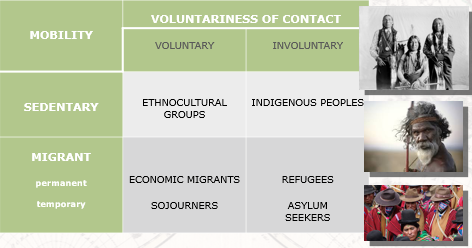
12
New cards
Sojourners vs immigrants
Sojourners = those who intend to stay temporarily
Immigrants = those who intend to stay permanently
Immigrants = those who intend to stay permanently
13
New cards
Ethnocultural groups
Descendants of earlier new settlements who have maintained a sense of their cultural origins and who form communities in their diasporas
Members have been enculturated and socialized in their culture. They don't have to acculturate themselves, unless their culture changes due to newcomers
Can derive from voluntary migrants or from involuntary migrants
E.g., voluntary: French Canadians, Greek-Australians, and Chinese-Australians
E.g., involuntary: African communities of former slaves in the US
National minorities similar group (Basque, Breton, Catalan, Friesian, Sami) territories have been forcefully incorporated in nation-state
Members have been enculturated and socialized in their culture. They don't have to acculturate themselves, unless their culture changes due to newcomers
Can derive from voluntary migrants or from involuntary migrants
E.g., voluntary: French Canadians, Greek-Australians, and Chinese-Australians
E.g., involuntary: African communities of former slaves in the US
National minorities similar group (Basque, Breton, Catalan, Friesian, Sami) territories have been forcefully incorporated in nation-state
14
New cards
Indigenous people
Those who are already on their home territories, but are engaged in intercultural contact with those who have migrated there to colonize/dominate them
In some societies (e.g., China, India), these groups are called national minorities
E.g., Uyghurs in China Tibet and North of Japan, Aboriginals, Native Americans, First Nations of Canada, etc.
In some societies (e.g., China, India), these groups are called national minorities
E.g., Uyghurs in China Tibet and North of Japan, Aboriginals, Native Americans, First Nations of Canada, etc.
15
New cards
Definitions of acculturation
McGee (1898): 4 stages - savagery, barbarism, civilization, enlightenment
Redfield, Linton, & Herskovits (1936): Subsequent changes in the original culture patterns of either or both groups
Berry (1992): Psychological consequences of having sustained contact with another culture
Doucerain et al. (2016): Multilevel, contextually dependent development change process
Redfield, Linton, & Herskovits (1936): Subsequent changes in the original culture patterns of either or both groups
Berry (1992): Psychological consequences of having sustained contact with another culture
Doucerain et al. (2016): Multilevel, contextually dependent development change process
16
New cards
Process of acculturation
Contact --> Influence --> Change
17
New cards
Difficulties in studying acculturation
Many different reasons for migrating;
Many different groups of acculturating people;
Many different experiences, e.g., depends on personality but also context: host cultural attitudes!
Scholars have many different viewpoints;
Studied from different disciplines;
Disagreement about process (directionality) of acculturation
Many different groups of acculturating people;
Many different experiences, e.g., depends on personality but also context: host cultural attitudes!
Scholars have many different viewpoints;
Studied from different disciplines;
Disagreement about process (directionality) of acculturation
18
New cards
Theoretical models of acculturation (directionality of change)
Acculturation is the shedding off of an old culture, taking on the new culture
Progressive adoption of foreign culture elements (ideas, words, values, norms, behavior, institutions) by persons, groups, or classes of a given culture
Progressive adoption of foreign culture elements (ideas, words, values, norms, behavior, institutions) by persons, groups, or classes of a given culture
19
New cards
Unidimensional models of acculturation
Individuals placed on a continuum of identities ranging from exclusively heritage culture to exclusively mainstream culture
Engagement of new culture inevitably linked to rejection of heritage culture: acculturation = assimilation
Assimilation as end-state (two opposing poles, with negative relation between orientation towards host and heritage culture)
You either identify with heritage culture OR new culture: no in-between
Engagement of new culture inevitably linked to rejection of heritage culture: acculturation = assimilation
Assimilation as end-state (two opposing poles, with negative relation between orientation towards host and heritage culture)
You either identify with heritage culture OR new culture: no in-between
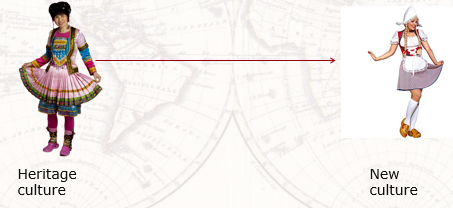
20
New cards
Bidimensional models of acculturation
Relationship with heritage and mainstream culture are conceptually independent cultural orientations (e.g., Berry's Fourfold Model)
Both heritage and mainstream cultural identities are free to vary independently
Individuals differ in extent to which self-identity includes culturally based values, attitudes, and behaviors (e.g., culture may play a large role in the identities of some individuals, whereas others may base their identity more on factors such as occupation or religion)
Assumes that individuals can have multiple cultural identities, each of which may independently vary in strength
Both heritage and mainstream cultural identities are free to vary independently
Individuals differ in extent to which self-identity includes culturally based values, attitudes, and behaviors (e.g., culture may play a large role in the identities of some individuals, whereas others may base their identity more on factors such as occupation or religion)
Assumes that individuals can have multiple cultural identities, each of which may independently vary in strength
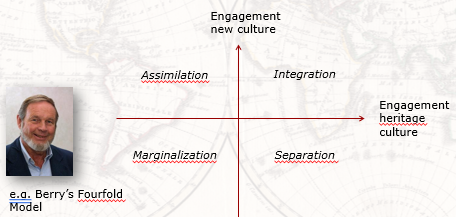
21
New cards
Integration strategy
Efforts to fit in and fully participate in host culture while striving to maintain traditions of heritage culture
22
New cards
Marginalization strategy
Little or no effort to participant in host culture or to maintain traditions of the heritage culture
23
New cards
Assimilation strategy
Efforts to fit in and fully participate in host culture, while making little or no effort to maintain traditions of heritage culture
24
New cards
Separation strategy
Efforts to maintain traditions of heritage culture, while making little or no effort to participate in host culture
25
New cards
Immigrant paradox
Children of immigrants have a variety of negative outcomes (e.g., lower educational achievement and poorer physical and mental health) than their parents
Paradox: Children of immigrants are more acculturated, or assimilated, than their immigrant parents -- yet they are worse off
Paradox: Children of immigrants are more acculturated, or assimilated, than their immigrant parents -- yet they are worse off
26
New cards
Identity denial
People's cultural identity is questioned because they are not recognized as matching the prototype of cultural group to which they belong
E.g., "No, where are you really from?"
E.g., "No, where are you really from?"
27
New cards
Stereotype threat
Fear of behaving in a way that will inadvertently confirm a negative stereotype about one's group
E.g., African American stereotype to perform worse academically --> realize they risk confirming a negative stereotype --> stereotype gets reproduced
E.g., African American stereotype to perform worse academically --> realize they risk confirming a negative stereotype --> stereotype gets reproduced
28
New cards
Unidimensional vs bidimensional scale (example)
Unidimensional scale (on what foods people prefer)
Native American foods only;
Mostly Native American foods and some other foods;
About equally Native American foods and other foods;
Mostly other foods;
Other foods only
Bidimensional scale
"I am interested in maintaining or developing Chinese traditions"
"I am interested in maintaining or developing American traditions"
Native American foods only;
Mostly Native American foods and some other foods;
About equally Native American foods and other foods;
Mostly other foods;
Other foods only
Bidimensional scale
"I am interested in maintaining or developing Chinese traditions"
"I am interested in maintaining or developing American traditions"
29
New cards
Comparison of unidimensional and bidimensional models with regard to self-identity
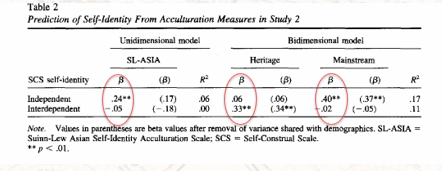
30
New cards
Which is better, Unidimensional or Bidimensional?
Bidimensional model constitutes a broader and more valid framework for understanding acculturation
Unidimensional model has the advantage of parsimony, but it offers an incomplete and often misleading rendering of acculturation process
Unidimensional model has the advantage of parsimony, but it offers an incomplete and often misleading rendering of acculturation process
31
New cards
Outcomes of acculturation
Sociocultural adaptation (doing well in new culture, ability to "fit in" or negotiate interactive aspects of life in a new cultural milieu);
Psychological adjustment (feeling well in new culture, mental health, well-being and satisfaction)
Psychological adjustment (feeling well in new culture, mental health, well-being and satisfaction)
32
New cards
Cultural fit hypothesis
Fit between personal characteristics and norms in host culture (e.g., extraversion in New Zealand vs Singapore)
E.g., correlation between individual patterns and average host country pattern (more extraverted = better outcomes in NZ than Singapore)
E.g., correlation between individual patterns and average host country pattern (more extraverted = better outcomes in NZ than Singapore)
33
New cards
Frameworks in the study of cross-cultural transitions
Clinical perspectives;
Social-learning models;
Social cognition approaches
Social-learning models;
Social cognition approaches
34
New cards
Acculturation profiles by length of residence
0-6 years: Much more likely to diffuse
6-12 years: Much more likely to integrate
12-18 years: Much more likely to integrate
Trends: integration increases with time; diffusion decreases; ethnic identity slowly decreases; national identity increases
6-12 years: Much more likely to integrate
12-18 years: Much more likely to integrate
Trends: integration increases with time; diffusion decreases; ethnic identity slowly decreases; national identity increases
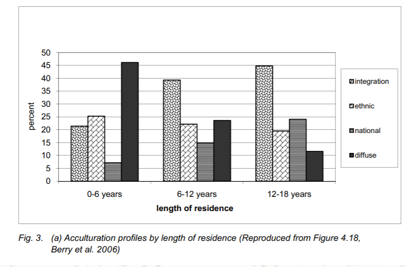
35
New cards
Psychological and sociological adaptation per acculturation profile
Integration profile: best psychological adaptation and good sociocultural adaptation
Ethnic identity: moderately good psychological adaptation but poorer sociocultural adaptation
National: moderately poor psychological adaptation and slightly negative sociocultural adaptation
Diffuse: worst psychological and sociocultural adaptation
Conclusion of results: youths should be encouraged to retain both a sense of own heritage cultural identity, while establishing close ties with larger national society
Ethnic identity: moderately good psychological adaptation but poorer sociocultural adaptation
National: moderately poor psychological adaptation and slightly negative sociocultural adaptation
Diffuse: worst psychological and sociocultural adaptation
Conclusion of results: youths should be encouraged to retain both a sense of own heritage cultural identity, while establishing close ties with larger national society
36
New cards
What is acculturative stress?
Psychological impact on the process of cultural adaptation. Reduction in mental health and well-being of ethnic minorities that occurs during the process of adaptation to a new culture
Undesirable "side-effects" of acculturation:
- language issues
- perceived cultural incompatibilities
- cultural self-consciousness
Undesirable "side-effects" of acculturation:
- language issues
- perceived cultural incompatibilities
- cultural self-consciousness
37
New cards
Measuring acculturative stress
Multidimensional acculturative stress inventory (MASI) for Hispanics in USA
English language competency pressures (e.g., "I don't speak English or don't speak it well");
Spanish language competency pressures (e.g., I feel pressure to learn Spanish");
Pressure to acculturate (e.g., "It bothers me when people pressure me to assimilate to the American ways of doing things");
Pressure against acculturation (e.g., "People look down upon me if I practice American customs")
(language competency pressures + pressure to acculturate)
Acculturative stress subscales = positively related to depression
English language competency pressures (e.g., "I don't speak English or don't speak it well");
Spanish language competency pressures (e.g., I feel pressure to learn Spanish");
Pressure to acculturate (e.g., "It bothers me when people pressure me to assimilate to the American ways of doing things");
Pressure against acculturation (e.g., "People look down upon me if I practice American customs")
(language competency pressures + pressure to acculturate)
Acculturative stress subscales = positively related to depression
38
New cards
What is biculturalism?
Those who have been exposed to and have internalized two cultures
People who have internalized two cultures to the extent that both cultures are alive inside of them (integration strategy: majority of acculturating individuals)
People who have internalized two cultures to the extent that both cultures are alive inside of them (integration strategy: majority of acculturating individuals)
39
New cards
What is an example of biculturalism?
"My cultures have very different views on things like dating and marriage. I feel like you have to choose one or the other" (19-year-old bicultural Indian American)
40
New cards
How do biculturals organize their identities?
Blending;
Frame-switching
Frame-switching
41
New cards
Blending vs. Frame-switching
Blending: Asian American, Dutch Moroccan
Frame-switching: Individual shifts between interpretive frames rooted in different cultures in response to cues in the social environment. May occur in response to cues such as contexts (home vs. school/work) and symbols (language) that are psychologically associated with one culture or the other
Two cultures can exist next to each other (the new one does not always replace the old one). Alternating!
Frame-switching: Individual shifts between interpretive frames rooted in different cultures in response to cues in the social environment. May occur in response to cues such as contexts (home vs. school/work) and symbols (language) that are psychologically associated with one culture or the other
Two cultures can exist next to each other (the new one does not always replace the old one). Alternating!
42
New cards
What is accessibility in regards to blending vs. frame-switching?
The more accessible a construct --> more likely to be prioritized in individual's mind and guide interpretations
Construct more accessible if activated by recent use (e.g., prime)
Construct more accessible if activated by recent use (e.g., prime)
43
New cards
Evidence for blending: Self-esteem change after 7 months
After living in Canada for 7 months, Japanese show a significant increase in self-esteem, whereas after living in Japan for 7 months, Canadians show a significant self-esteem decrease
Conclusion: the longer one is in a culture, the more likely it is that the metaschema of thoughts and feelings that are activated is associated with host culture
BUT self-esteem (and other) change is probably more pronounced if there is a 'melting-pot' culture (assimilation) than a 'salad-bowl' culture (integration/separation)
Conclusion: the longer one is in a culture, the more likely it is that the metaschema of thoughts and feelings that are activated is associated with host culture
BUT self-esteem (and other) change is probably more pronounced if there is a 'melting-pot' culture (assimilation) than a 'salad-bowl' culture (integration/separation)
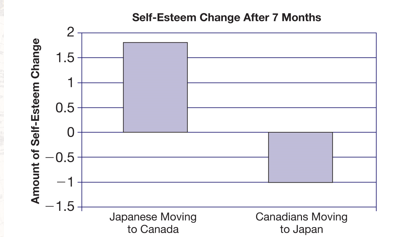
44
New cards
What is a melting pot culture?
Various immigrant groups “melt together" --> abandoning their individual cultures and eventually becoming fully assimilated into the predominant society
E.g., United States
E.g., United States
45
New cards
What is a salad bowl culture?
Multicultural society can integrate different cultures while maintaining their separate identities
E.g., Chinatown in San Francisco
E.g., Chinatown in San Francisco
46
New cards
Evidence for blending: Self-esteem and exposure to North-American culture
On average, the more exposure one has to North American culture, the higher one's self-esteem is
E.g., third-generation Asian-Canadians same level self-esteem as European-Canadians (but not second-generation, first-generation, etc.)
E.g., third-generation Asian-Canadians same level self-esteem as European-Canadians (but not second-generation, first-generation, etc.)
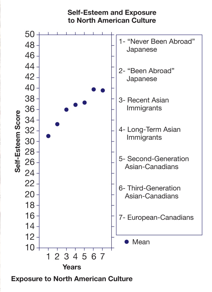
47
New cards
Evidence for frame-switching
North Americans more likely to attribute behavior to internal dispositions ('fundamental attribution error')
East Asians more likely to make external attributions (social context, group)
Why is the single fish swimming ahead of the group?
--> Chased by others (external attribution): East Asians
--> Leading the group (internal attribution): N-Americans
East Asians more likely to make external attributions (social context, group)
Why is the single fish swimming ahead of the group?
--> Chased by others (external attribution): East Asians
--> Leading the group (internal attribution): N-Americans
48
New cards
Evidence for frame-switching: Hong-Kong Westernization
Hong Kong is Westernized to a large extent because of strong English colonial influence
When primed w/ Chinese symbols (Chinese dragon/rice farmer) --> more external attribution (e.g., "fish is being chased")
When primed w/ American symbols (mickey mouse/cowboy) --> more internal attribution (e.g., "fish is the leader")
When primed w/ Chinese symbols (Chinese dragon/rice farmer) --> more external attribution (e.g., "fish is being chased")
When primed w/ American symbols (mickey mouse/cowboy) --> more internal attribution (e.g., "fish is the leader")

49
New cards
Bicultural identity integration (BII)
The extent to which bicultural people see their two cultural identities as compatible or in opposition to each other (individual-level indicator)
(how well people manage their dual cultural identities)
(how well people manage their dual cultural identities)
50
New cards
Independent components of BII
BII harmony (vs conflict): feelings and attitudes towards cultures (i.e., degree of dissociation vs. overlap perceived between cultures)
BII blendedness (vs compartmentalization): organization and structure of cultural orientations (i.e., degree of tension vs. compatibility between cultures)
Low BII people: have difficulty incorporating both cultures into a cohesive identity -- both cultures are highly dissimilar
High BII people: see themselves as part of a “third” culture, integrating elements from both their cultures
High BII associated with more positive outcomes (e.g., self-esteem, well-being) and better at frame-switching
BII blendedness (vs compartmentalization): organization and structure of cultural orientations (i.e., degree of tension vs. compatibility between cultures)
Low BII people: have difficulty incorporating both cultures into a cohesive identity -- both cultures are highly dissimilar
High BII people: see themselves as part of a “third” culture, integrating elements from both their cultures
High BII associated with more positive outcomes (e.g., self-esteem, well-being) and better at frame-switching
51
New cards
Harmony vs conflict of BII (scale example)
"I find it easy to harmonize ______ and American cultures"
"I feel that my _______ and American cultures are incompatible"
(Items rated on a 1 to 5 scale)
"I feel that my _______ and American cultures are incompatible"
(Items rated on a 1 to 5 scale)
52
New cards
Blendedness vs compartmentalization (scale example)
"I feel ________ and American cultures at the same time"
"I do not blend my ________ and American cultures"
"I do not blend my ________ and American cultures"
53
New cards
Biculturalism threats example
French football players ("Africanness" and assimilationism)
54
New cards
Third culture kids (TCKs)
People who travel with their expat parents and spend large parts of their youth living in places outside their heritage culture
Also known as global nomads (AUC kids)
Also known as global nomads (AUC kids)
55
New cards
Integrative complexity
Experiencing life in unfamiliar cultures -- willingness and ability to acknowledge and consider different viewpoints on the same issue
E.g., participants primed for adapting to a new culture --> more creativity in their drawings
E.g., participants primed for adapting to a new culture --> more creativity in their drawings
56
New cards
Moral relativism
Belief that what is right or wrong is not absolute; it depends on different cultural factors --> more likely to act immorally (cheating on a task for money)
(a downside of learning about other cultures = exposes you to alternative systems of moral values)
(a downside of learning about other cultures = exposes you to alternative systems of moral values)
57
New cards
Prevalence of psychiatric diagnoses
Psychopathology present in all studied societies (people suffer all over the world)
Diagnostic differences: differences in what qualifies as mental psychopathology (do diagnostic practices reflect particular cultural views in e.g., China and Chile?)
Differences in expression: e.g., low anxiety in Ankara compensated by higher depression? And the other way around in Athens?
Diagnostic differences: differences in what qualifies as mental psychopathology (do diagnostic practices reflect particular cultural views in e.g., China and Chile?)
Differences in expression: e.g., low anxiety in Ankara compensated by higher depression? And the other way around in Athens?

58
New cards
Edward Shorter (social historian) contribution
Each culture provides a symptom pool of recognized and discussed symptoms that leads people to express their inner conflicts in a familiar language
Culture-bound vs. universal syndromes
Culture-bound vs. universal syndromes
59
New cards
Culture-bound symptoms according to DSM-V
Psychological symptoms that are greatly influenced by cultural factors --> thus occur less often and manifest in diverse ways (context-dependent)
60
New cards
Anorexia nervosa
Refusal to maintain normal body weight, an intense fear of gaining weight or becoming fat, and denial of dangers of low body weight
61
New cards
Bulimia nervosa
Recurring episodes of binge eating --> prevent weight gain by means of purging, self-induced vomiting, misuse of laxatives, excessive exercise
(occurring at least twice per week for 2 months)
(occurring at least twice per week for 2 months)
62
New cards
Ataques de nervios
Convulsions, partial loss of consciousness, heart palpitations, numbness, sudden outbursts, sense of heat rising to the head
(culturally recognized means of communicating strong emotions and to protest unfair treatment)
(Latin America)
(culturally recognized means of communicating strong emotions and to protest unfair treatment)
(Latin America)
63
New cards
Amok
Sudden outburst of uncontrolled behavior or unrestrained violence, preceded by a period of worrying and ending with exhaustion and amnesia
(Southeast Asia)
(Southeast Asia)
64
New cards
Frigophobia
Morbid fear of catching a cold --> people dress in heavy coats and scarves, even in summer
(China)
(China)
65
New cards
Susto
People feel a frightening experience has caused their soul to get dislodged from their body --> many physical and psychological symptoms
(Latin America)
(Latin America)
66
New cards
Voodoo death
People are convinced a curse has been put on them, or that they have broken a taboo --> sometimes leads to death
(Africa)
(Africa)
67
New cards
Latah
Falling into a transient dissociated state and exhibit unusual behaviors (e.g., barking like a dog, shouting sexually charged statements, acting in culturally inappropriate ways). Person often has no memory of outburst
(Southeast Asia, Siberia, Japan)
(Southeast Asia, Siberia, Japan)
68
New cards
Malgri
Territorial anxiety: when entering new territories without engaging in appropriate ceremonial procedures --> belief of invasion by a spirit --> physically sick and drowsy
(Australian Aboriginals)
(Australian Aboriginals)
69
New cards
Agonias
Anxiety disorder including burning sensation, loss of breath, hysterical blindness, sleep problems, eating disorders
(Portugal)
(Portugal)
70
New cards
Kufungisisa
"Thinking too much": associated with anxiety and physical problems that stem from mental exhaustion. Belief that mind has been damaged by fatigue --> panic attacks and irritability
(Zimbabwe, Caribbean, Native Americans, East Asians)
(Zimbabwe, Caribbean, Native Americans, East Asians)
71
New cards
Effect of culture on psychopathology
Cultures differ in the extent to which certain mental illnesses are prevalent and in the extent to which certain symptoms are part of (universal) mental illnesses
E.g., cultural traditions in rural Southeast Asia demand that people remain passive and non-confrontational. Some individuals who are unable to find culturally sanctioned means to express their frustration ultimately explode is an uncontrolled anger reaction and unresolved tensions ("running amok")
E.g., cultural traditions in rural Southeast Asia demand that people remain passive and non-confrontational. Some individuals who are unable to find culturally sanctioned means to express their frustration ultimately explode is an uncontrolled anger reaction and unresolved tensions ("running amok")
72
New cards
Effect of culture on psychopathology (2)
Cultures also differ in the way mental illnesses are perceived (e.g., stigma) and dealt with (therapy)
73
New cards
Schizophrenia symptoms
Delusions;
Hallucinations;
Disordered thinking;
Disorganized speech;
Disorganized or catatonic behavior;
Lack of insight;
Flattened affect
Hallucinations;
Disordered thinking;
Disorganized speech;
Disorganized or catatonic behavior;
Lack of insight;
Flattened affect
74
New cards
Schizophrenia causes
Genetic factors, prenatal conditions, but environmental factors may or may not trigger one's disposition (see identical twins)
75
New cards
Schizophrenia types of delusions
Auditory/visual/tactile, grandiose
76
New cards
Disorganized schizophrenia symptoms
Problems with thinking and expressing ideas clearly;
Childlike behavior;
Showing little emotion;
Disinhibited, agitated, and purposeless behavior
Cannot perform daily activities (e.g., preparing meals and taking care of personal hygiene)
Childlike behavior;
Showing little emotion;
Disinhibited, agitated, and purposeless behavior
Cannot perform daily activities (e.g., preparing meals and taking care of personal hygiene)
77
New cards
Paranoid schizophrenia symptoms
Anxious, angry, or argumentative behavior;
False beliefs that others are trying to harm you or your loved ones
False beliefs that others are trying to harm you or your loved ones
78
New cards
Catatonic schizophrenia
Lack of activity or hyperactivity;
Erratic movements;
Muscles and posture is rigid, repetitive-cramp-like;
Grimaces or other odd expressions
Not responding much to other people
Erratic movements;
Muscles and posture is rigid, repetitive-cramp-like;
Grimaces or other odd expressions
Not responding much to other people
79
New cards
Schizophrenia prevalence of subtypes (cultural variations)
Paranoia (delusional visions) more frequent in UK, catatonic (motor activity) more frequent in India
Existential universal: emerges across culture with relatively stable prevalence rates & symptoms w/ cultural variance in modes of expression
Existential universal: emerges across culture with relatively stable prevalence rates & symptoms w/ cultural variance in modes of expression
80
New cards
Schizophrenia course and prognosis (cultural variations: non-industrialized vs industrialized)
Better in non-industrialized societies vs. industrialized:
1. People in less-developed societies tend to have a more fatalistic attitude and less of a primary sense of control (less blameworthy actions towards the schizophrenic because that behavior is more normalized)
2. Hallucinations/beliefs in possession by spirits more common in less-developed societies (possession by spirits seen as the main cause --> not people's own fault and more social support received)
3. More integrated in the society --> stronger sense of community --> less chance of mental illness
1. People in less-developed societies tend to have a more fatalistic attitude and less of a primary sense of control (less blameworthy actions towards the schizophrenic because that behavior is more normalized)
2. Hallucinations/beliefs in possession by spirits more common in less-developed societies (possession by spirits seen as the main cause --> not people's own fault and more social support received)
3. More integrated in the society --> stronger sense of community --> less chance of mental illness
81
New cards
Depression symptoms
Depressed mood;
Feelings of worthlessness or guilt (psychological);
Change in weight or appetite;
Sleep problems;
Poor concentration;
Fatigue (physiological)
Feelings of worthlessness or guilt (psychological);
Change in weight or appetite;
Sleep problems;
Poor concentration;
Fatigue (physiological)
82
New cards
Depression causes
Neurotransmitter imbalance, stress associated with tragic life events
83
New cards
Depression prevalence (cultural variations)
1% in China vs. 10.5% in the US
84
New cards
Symptom expression of depression (cultural variations)
Somatization (Chinese): people are primarily experiencing symptoms in their bodies
Psychologization (Westerners): people are primarily experiencing symptoms in their minds
Social stigma associated with having a psychological disease are greater in Chinese contexts --> little discussion about mental issues
Less focus on internal (emotional) events as relevant in Chinese compared to Westerners
Psychologization (Westerners): people are primarily experiencing symptoms in their minds
Social stigma associated with having a psychological disease are greater in Chinese contexts --> little discussion about mental issues
Less focus on internal (emotional) events as relevant in Chinese compared to Westerners
85
New cards
Social Anxiety Disorder symptoms
Fear of acting unacceptably, which would result in social rejection
86
New cards
Social Anxiety Disorder prevalence (cultural variations)
0.5% in East Asia, 7% in the US
Interdependence --> social anxiety concerns
More social anxiety concerns, but less diagnosis in East Asia (experiencing concerns about others is culturally normative --> symptoms perceived as less problematic and more normal --> clinical criteria not often met)
87
New cards
Taijin Kyoufushou (TKS)
Similar to social anxiety disorder (triggered by social situations);
Preoccupation with physical symptoms (blushing, sweating, penetrating gaze, body odor);
"Phobia of offending others"
Preoccupation with physical symptoms (blushing, sweating, penetrating gaze, body odor);
"Phobia of offending others"
88
New cards
TKS vs Social Anxiety Disorder
Preoccupation of making others uncomfortable vs. self
High prevalence among men vs. women
High prevalence only in Japan (lifetime prevalence 3-13%)
High prevalence among men vs. women
High prevalence only in Japan (lifetime prevalence 3-13%)
89
New cards
Hikikomori
"Pull inward" or social withdrawal: voluntary absence of social interaction outside of family members for at least 6 months
(typical among adolescent Japanese students)
(typical among adolescent Japanese students)
90
New cards
Dhat syndrome
Belief among young men that they are leaking semen --> causes them to be anxious because semen considered to be a source of vitality --> loss of semen from masturbation = guilt and anxiety
91
New cards
Western therapist vs. East-Asian client
Western therapist variables:
1) Same degree of stereotypes as general pop --> self-fulfilling prophecy (patient is misunderstood, not possible to build trusting relationship)
2) Training bias (little attention to whether techniques work cross-culturally). Focus on individual (vs group), agency as primary control (vs secondary)
East-Asian client variables:
1) Higher tolerance for ambiguity
2) More respect for authority (less likely to go against interpretation of therapist)
3) Less emotional display (interpreted as shy)
4) Expression of symptoms of body rather than mind (somatization vs psychologization)
Preferred type of therapist for patients w/ Asian backgrounds:
Active role as healer (assertive by explicitly expressing own opinions)
1) Same degree of stereotypes as general pop --> self-fulfilling prophecy (patient is misunderstood, not possible to build trusting relationship)
2) Training bias (little attention to whether techniques work cross-culturally). Focus on individual (vs group), agency as primary control (vs secondary)
East-Asian client variables:
1) Higher tolerance for ambiguity
2) More respect for authority (less likely to go against interpretation of therapist)
3) Less emotional display (interpreted as shy)
4) Expression of symptoms of body rather than mind (somatization vs psychologization)
Preferred type of therapist for patients w/ Asian backgrounds:
Active role as healer (assertive by explicitly expressing own opinions)
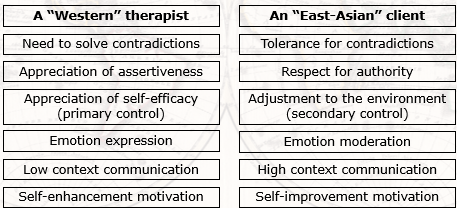
92
New cards
What approach do most Western therapists follow?
Cognitive and rational approach (to understand the nature and cause of problems)
In contrast, some Eastern therapists stress importance of actual experience without cognitive understanding
In contrast, some Eastern therapists stress importance of actual experience without cognitive understanding
93
New cards
Outcomes of cross-cultural psychotherapy (Sue, 2009)
Higher and premature drop-out rates in cross-cultural counseling;
Cross-cultural counselor rated as less effective/satisfying;
Culturally adapted psychotherapy 4x more effective than general approach
Asian-, African, Mexican-Americans = more sessions, less drop out, and better treatment outcomes when they saw a therapist who was matched ethnically and linguistically
Cross-cultural counselor rated as less effective/satisfying;
Culturally adapted psychotherapy 4x more effective than general approach
Asian-, African, Mexican-Americans = more sessions, less drop out, and better treatment outcomes when they saw a therapist who was matched ethnically and linguistically
94
New cards
What is a culturally competent therapist?
1) Recognize own cultural influences;
2) Develop knowledge about client's culture and how integrated the client is in mainstream culture
3) Culturally sensitive
4) Flexible (when to generalize from the client's culture to mainstream culture and when to individualize the client)
2) Develop knowledge about client's culture and how integrated the client is in mainstream culture
3) Culturally sensitive
4) Flexible (when to generalize from the client's culture to mainstream culture and when to individualize the client)
95
New cards
The findings from acculturation research are less coherent than many other topics. Why?
a. One cannot put people through an acculturation experiment; it's all correlational research
b. There are no validated acculturation measures
c. People's circumstances vary so much that it's hard to identify common patterns
d. There is no agreement on the definition of acculturation
e. Immigrants do not like to have their experiences studied by researchers
a. One cannot put people through an acculturation experiment; it's all correlational research
b. There are no validated acculturation measures
c. People's circumstances vary so much that it's hard to identify common patterns
d. There is no agreement on the definition of acculturation
e. Immigrants do not like to have their experiences studied by researchers
Correct answer: c
96
New cards
Research on personality and acculturation reveals that:
a. introverts tend to be more successful at acculturating than extraverts
b. extraverts tend to be more successful at acculturating than introverts
c. extraverts tend to proceed through a more severe period of culture shock on the acculturation curve compared with introverts
d. introverts fare worse early on, whereas extraverts tend to fare worse over the long run
e. None of the above
a. introverts tend to be more successful at acculturating than extraverts
b. extraverts tend to be more successful at acculturating than introverts
c. extraverts tend to proceed through a more severe period of culture shock on the acculturation curve compared with introverts
d. introverts fare worse early on, whereas extraverts tend to fare worse over the long run
e. None of the above
Correct answer: e
Success of acculturation highly depends on context (e.g., if you are an introvert --> you move to a society with mostly introverted country --> more successful than extraverts)
Success of acculturation highly depends on context (e.g., if you are an introvert --> you move to a society with mostly introverted country --> more successful than extraverts)
97
New cards
Bjorn is a nonvisible minority member, while Trang is a member of a visible minority. Trang is more likely than Bjorn to:
a. experience an L-shaped acculturation curve
b. have his acculturative stress be influenced by his initial experiences in the host culture
c. have a personality with poor cultural fit
d. have a separation acculturation strategy
e. use blending
a. experience an L-shaped acculturation curve
b. have his acculturative stress be influenced by his initial experiences in the host culture
c. have a personality with poor cultural fit
d. have a separation acculturation strategy
e. use blending
Correct answer: d
98
New cards
Stereotype threat occurs for what reason?
a. It is damaging to one's self-esteem if others share negative stereotypes of your group
b. People risk behaving in ways consistent with stereotypes, thereby proving the stereotype and creating a self-fulfilling prophecy
c. Everyone believes in the content of stereotypes, even if
they won't consciously admit it
d. People apply stereotypes to groups they don't like
e. Stereotypes are vulnerable to being disproved by counter-stereotypical information
a. It is damaging to one's self-esteem if others share negative stereotypes of your group
b. People risk behaving in ways consistent with stereotypes, thereby proving the stereotype and creating a self-fulfilling prophecy
c. Everyone believes in the content of stereotypes, even if
they won't consciously admit it
d. People apply stereotypes to groups they don't like
e. Stereotypes are vulnerable to being disproved by counter-stereotypical information
Correct answer: b
99
New cards
Jee-Yeong is a bicultural Korean Canadian who has high bicultural identity integration. Compared with other bicultural Korean Canadians who have low bicultural identity integration, Jee-Yeong:
a. will show less acculturative stress
b. is more likely to score high on measures of cultural distance
c. is less likely to acquire undesirable cultural habits
d. will engage in more frame-switching
e. will more likely adopt an assimilation strategy
a. will show less acculturative stress
b. is more likely to score high on measures of cultural distance
c. is less likely to acquire undesirable cultural habits
d. will engage in more frame-switching
e. will more likely adopt an assimilation strategy
Correct answer: d
100
New cards
How is creativity related to multicultural experiences?
a. The kinds of travel destinations of creative people are more exotic than are those of less creative people
b. Creative people tend to congregate in international creative centers, such as Paris and New York
c. Creative people are more likely to have adapted to life in more than one culture
d. Because multicultural people have confused identities, people need to become creative to derive a clear narrative from their lives
e. Multicultural people have been exposed to a broader array of artistic traditions in their lives
a. The kinds of travel destinations of creative people are more exotic than are those of less creative people
b. Creative people tend to congregate in international creative centers, such as Paris and New York
c. Creative people are more likely to have adapted to life in more than one culture
d. Because multicultural people have confused identities, people need to become creative to derive a clear narrative from their lives
e. Multicultural people have been exposed to a broader array of artistic traditions in their lives
Correct answer: c